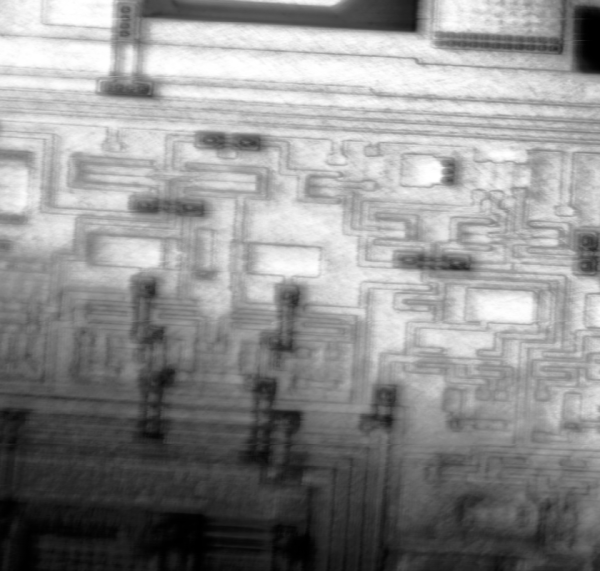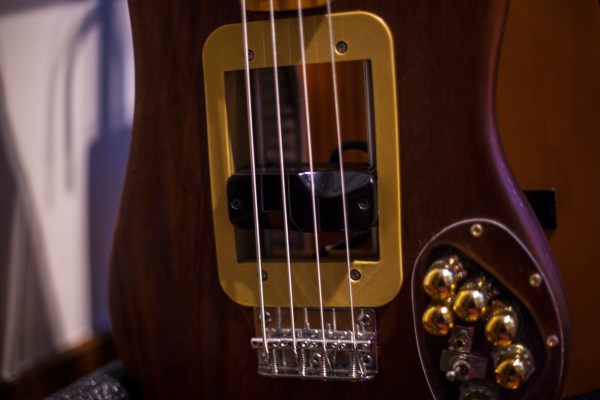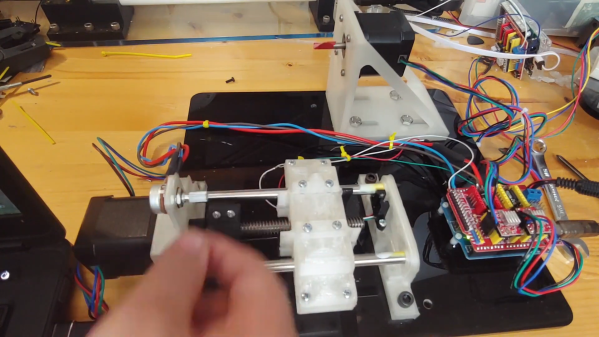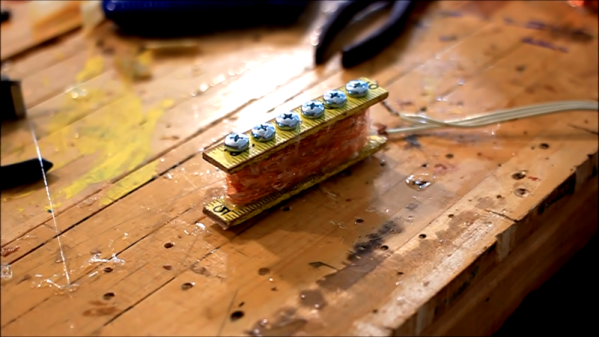Sure, it does less than originally promised, but hey — at least it’s more expensive. That about sums up Tesla fans’ feelings after the long-awaited Cybertruck reveal at the Texas Gigafactory on Thursday, where Elon Musk himself handed over the keys — or their Cyber equivalent — to a few new owners. These are expensive machines — $61,000 for the two-motor model, and just shy of $100,000 for the three-motor all-wheel-drive model with all the bells and whistles. That’s considerably more than they were expected to cost back in 2019, a fact which may be at least partially behind the drop in Tesla shares after the launch.
pickup14 Articles
DVD Drives Turned Into Microscopes
With the advent of streaming services, plenty of people are opting to forego the collection of physical media. In turn, there are now a lot of optical drives sitting unused in parts bins and old computers. If you’d like something useful to do with this now-obsolete technology, you can have a try at turning one into a laser microscope.
This build requires two DVD pickups. By scanning once horizontally and once vertically and measuring the returning light from the DVD laser, an image can be created. For this build, the second pickup is used to move the object itself. The entire device is controlled by an Analog Discovery 2, although this principle could be ported to other microcontroller platforms. Thanks to the extremely fine laser in a DVD and the precise movements of the motors found in the control machinery, the images obtained using this method have the potential to be more detailed than comparable visible light microscopes.
While this isn’t quite scanning electron microscope territory, it’s good enough to clearly image the internal workings of a de-capped integrated circuit. Something like this could be indispensable for reverse-engineering ICs or troubleshooting other comparably small electronics, with resolutions higher than can typically be obtained with visible light microscopes. We’ve even seen similar builds in the past which build microscopes like this as dedicated lab equipment.
Bass Guitar Gets Shapeshifting Pickups
Electric guitars were the hip new thing back in the mid-century. The electrification of the common and portable guitar opened up a lot of avenues in terms of sound and technique. Specifically, the use of the pickup, an electromagnetic device which converts the vibrations of the guitar strings into electrical signals, increased the number of ways that a musician can alter the guitar’s sound on-the-fly. Some guitars have several rows of pickups which can be used in any number of ways, but this custom guitar has a single pickup which can be moved around the guitar’s body instead.
[Breno] was gifted this Dolphin bass guitar to start learning after years of playing a regular guitar, and while they aren’t known for high-quality instruments this guitar seemed to play and sound well enough to attempt this modification. First, a hole had to be cut all the way through the guitar’s body in order to accommodate the build. The pickup for this guitar is then mounted on two rods which allow it to move in various positions along the strings, and a second set of adjustments can be made to bring the pickups closer or further away from the strings. Some additional custom circuitry was added to control it and also to handle the volume and tone knobs, and while this was being added [Breno] and his friend [Arthur] decided this would be a great time to build some effects into the guitar’s now-custom electronics as well.
While this was largely a project for [Breno] to understand in greater depth the effect of moving the pickups around an electric guitar, the finished product looks ready to play some live shows. The addition of some extras like the effects really adds some punch to this guitar and it looks to be completely original. The nearest thing we could find is this guitar which uses hot-swappable pickups but even those are mounted in fixed locations.
Tonewheels Warble In This Organ-Inspired Musical Instrument
Younger readers may not recall the days when every mall had a music store — not the kind where tapes and LPs were sold, but the kind where you could buy instruments. These places inevitably had an employee belting out mall-music to all and sundry on an electric organ. And more often than not, the organist was playing a Hammond organ, with the distinct sound of these instruments generated by something similar to this tonewheel organ robot.
Tonewheels are toothed ferromagnetic wheels that are rotated near a pickup coil. This induces a current that can be amplified; alter the tooth profile or change the speed of rotation, and you’ve got control over the sounds produced. While a Hammond organ uses this technique to produce a wide range of sounds, [The Mixed Signal]’s effort is considerably more modest but nonetheless interesting. A stepper motor and a 1:8 ratio 3D-printed gearbox power a pair of shafts which each carry three different tonewheels. The tonewheels themselves are laser-cut from mild steel and range from what look like spur gears to wheels with but a few large lobes. This is a step up from the previous version of this instrument, which used tonewheels 3D-printed from magnetic filament.
Each tonewheel has its own pickup, wound using a coil winder that [TheMixed Signal] previously built. Each coil has a soft iron core, allowing for the addition of one or more neodymium bias magnets, which dramatically alters the tone. The video below shows the build and a demo; skip ahead to 16:10 or so if you just want to hear the instrument play. It’s — interesting. But it’s clearly a work in progress, and we’re eager to see where it goes. Continue reading “Tonewheels Warble In This Organ-Inspired Musical Instrument”
A Pair Of Steppers Are Put To Work In This Automatic Instrument Pickup Winder
For something that’s basically a coil of wire around some magnetic pole pieces, an electric guitar pickup is a complicated bit of tech. So much about the tone of the instrument is dictated by how the pickup is wound that controlling the winding process is something best accomplished with a machine. This automatic pickup winder isn’t exactly a high-end machine, but it’s enough for the job at hand, and has some interesting possibilities for refinements.
First off, as [The Mixed Signal] points out, his pickups aren’t intended for use on a guitar. As we’ve seen before, the musical projects he has tackled are somewhat offbeat, and this single-pole pickup is destined for another unusual instrument. That’s not to say a guitar pickup couldn’t be wound on this machine, of course, as could inductors, solenoids, or Tesla coils. The running gear is built around two NEMA-17 stepper motors, one for the coil spindle and one for the winding carriage. The carriage runs on a short Acme lead screw and linear bearings, moving back and forth to wind the coil more or less evenly. An Arduino topped with a CNC shield runs the show, allowing for walk-away coil winding.
We do notice that the coil wire seems to bunch up at the ends of the coil form. We wonder if that could be cured by speeding up the carriage motor as it nears the end of the spool to spread the wire spacing out a bit. The nice thing about builds like these is the ease with which changes can be made — at the end of the day, it’s just code.
Continue reading “A Pair Of Steppers Are Put To Work In This Automatic Instrument Pickup Winder”
3D Printering: Selling Prints, And Solving The Pickup Problem
After getting a 3D printer up and running, it’s not uncommon for an enterprising hacker to dabble in 3D printing to make a little money on the side. Offering local pickup of orders is a common startup choice since it’s simple and avoids shipping entirely. It’s virtually tailor-made to make a great bootstrapping experiment, but anyone who tries it sooner or later bumps up against a critical but simple-seeming problem: how to get finished prints into a customer’s hands in a sustainable way that is not a hassle for either the provider, or the customer?
It’s very easy to accept a 3D file and get paid online, but the part about actually getting the print into the customer’s hands does not have a one-size-fits-all solution. This is what I call The Pickup Problem, and left unsolved, it can become unsustainable. Let’s look at why local pickup doesn’t always measure up, then examine possible solutions.
The Problems with Local Pickup
Local pickup for delivery of print jobs is great because there is no mucking about with shipping supplies or carriers. Also, many 3D prints when starting out will be relatively low-value jobs that no one is interested in stacking shipping fees onto, anyway.
“Your order is complete. Come to this address to pick up your order.” It is straightforward and hits all the bases, so what’s the problem?
Continue reading “3D Printering: Selling Prints, And Solving The Pickup Problem”
Building Your Own Guitar Pickup From Scrap
Pickups are a key part of an electric guitar’s sound. You can spend a king’s ransom on tracking down just the right Vintage American Original 1950s Whatevers (TM) to put in your Spudocaster, but it’s not the only way. [Keith Decent] decided to make a pickup from scratch, using only materials found lying around the workshop. (Youtube, embedded below).
To build a pickup, you’ll want some magnet wire. In this case, [Keith] harvests this from an old transformer. A pickup body is then constructed from an old wooden ruler and some machine screws. A drill is used to spin the pickup body while the wire is roughly wound on, and everything is then held together with lashings of hot glue.
It’s a grungy build with a very Mad Max vibe – with the perfect aesthetic to suit [Keith]’s junkbox guitar build. The sound is good, but difficult to rate accurately when used on a guitar with slightly imperfect intonation. We’d love to hear it installed on a well-tuned body to get a better comparison.
It goes to show you don’t need to spend money on new parts and tools to get a build started. Sometimes you can make something perfectly functional with stuff you have lying around at home. Video after the break.
Continue reading “Building Your Own Guitar Pickup From Scrap”


















